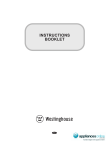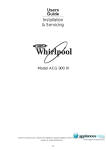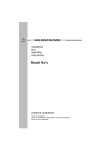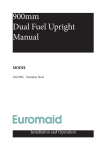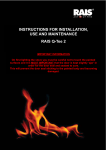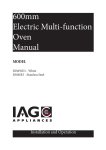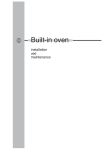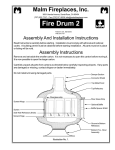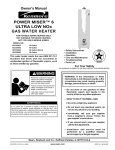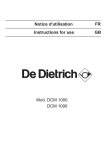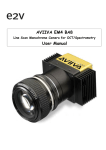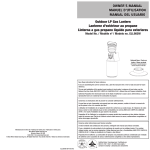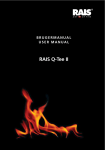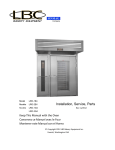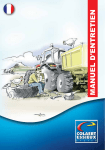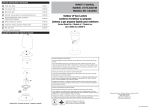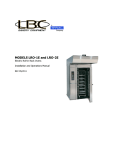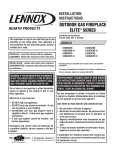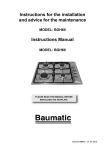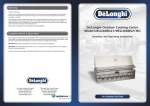Download Whirlpool ACG902IX Cooktop User Manual
Transcript
Users Guide Installation & Servicing Model ACG 902 IX NOTE TO INSTALLER: LEAVE THE OWNERS GUIDE MANUAL WITH THE APPLIANCE. (Keep For Future Reference) AU WHEN YOU CALL FOR SERVICE Costumer Service: 1300 363 344 Service call booking: 1300 361 166 RECORD HERE FOR EASY REFERENCE Model Serial Number Colour Whirlpool Europa S.r.l. Viale G. Borghi, 27 21025 Comerio (VA) Italy Installation Date Dealer's Name and Address When you call for service or order parts for your unit, be sure to give: 1. MODEL 2. SERIAL NUMBER 3. COLOUR 4. PART NAME and/or description of problem 5. YOUR FULL NAME, ADDRESS, and HOME TELEPHONE NUMBER and BUSINESS TELEPHONE NUMBER IF APPROPRIATE. GENERAL INFORMATION ENVIRONMENTAL WARNING Waste packaging Do not throw the packaging of your appliance into the dustbin, but pick out the different materials (for instance foil, paperboard, polystyrene) according to the local rules for rubbish elimination. SECTION FOR THE QUALIFIED TECHNICIAN This appliance must only be used for the purpose of domestic cooking. OV E R A L L D I M E N S I O N S Getting to know your new cooker WARNING -Accessible parts will become hot when in use. To avoid burns and scalds children should be kept away. 895 - WARNING In order to prevent accidental tipping of the appliance, for example by a child climbing onto the open oven door, the stabilizing means must be installed. - WARNING This appliance is not intended for use by persons (including children) with reduced physical, sensory or mental capabilities, or lack of experience and knowledge, unless they have been given supervision or instruction concerning use of the appliance by a person responsible for their safety. Children should be supervised to ensure that they do not play with the appliance. Young children and infirm persons should not be left unsupervised in the vicinity. - WARNING Before you use the appliance for the first time, check that the plastic films protecting some parts (fascia panel, parts in stainless steel, etc.) have been removed. - WARNING: A steam cleaner is not to be used cleaning this appliances. - WARNING DO NOT place inflammable materials or plastic utensils in the warming drawer. DO NOT SPRAY AEROSOLS IN THE VICINITY OF THIS APPLIANCE WHILE IT IS IN OPERATION. Not for use in marine craft, caravans or mobile homes unless each burner is fitted with a flame safeguard. WHERE THIS APPLIANCE IS INSTALLED IN MARINE CRAFT OR IN CARAVANS, IT SHALL NOT BE USED AS A SPACE HEATER DO NOT MODIFY THIS APPLIANCE. 2 600 100 725 25 Thank you for choosing one of our products. Our cookers are of simple, rational design. They are constructed to the best standards to ensure good service and outstanding safety. Please read this manual carefully; it will provide all the advice needed to allow you to obtain the best results from the very first day. ATTENTION: - Before using the appliance, do not forget to remove the plastic protective film from parts of the appliance. No part of any adjoining wall surface can be made of combustible materials. The protection of combustible materials required by Clause 5.12.1.1 of AS5601-2004 is the fixing of 5 mm thick ceramic tiles to the surface or attaching fire resistant material to the surface and covering with sheet metal with a minimum thickness of 0.4 mm. POSITIONING If the range is placed on a base, ensure measures are taken to prevent the product slipping off the base Make sure that the wall surface behind the Cooker is noncombustable (will not catch fire). A plastered or tiled wall is ideal. Where a painted surface is adjacent, a fire retardent paint surface is recommended. Wallpaper, wood, or fabric should not be used behind or next to the cooker. Any adjoining wall surface situated within 200mm from the edge of any hob burner must be suitable non-combustible material for a height of 150mm for the entire length of the hob. Any combustible construction above the hotplate must be at least 650mm above the maintop. Clearances to non- combustible materials non- combustible materials PROVISION FOR VENTILATION The room where the Cooker is installed should have permanent ventilation as follows: Ventilation must be in accordance with AS5601- 2004 - Gas Installations. In general, the appliance should have adequate ventilation for complete combustion of gas, proper flueing and to maintain temperature of immediate surroundings within safe limits. - Do not install in a bed-sitting room, a bathroom or shower room. If there is another fuel burning appliance in the same room, a higher level of ventilation will be required, you should consults " the safety requirements". In addition to the above, during prolonged use, opening a window in the same room is recommended. This will avoid the build up of excessive moisture and condensation. POSITIONING Important: Fix the chain located next to the gas connection on both sides of the cooker to the wall to prevent the cooker from tilting. Both chains must be securely fixed. Make sure that the wall surface behind the Cooker is noncombustable (will not catch fire). Where a painted surface is adjacent, a fire retardent paint surface is recommended. Wallpaper, wood, or fabric should not be used behind or next to the cooker. Clearances to combustible materials "0" mm "0" mm "0" mm OK Fig. 1 B 1 min. 400 mm min. 650 mm min.10 mm "0" mm min "60" mm Note: The cooker is fitted with 4 legs which must be assembled as shown in figure 1B. Any adjoining wall surface (side or rear) situated within 200mm of any hob burner must be a suitable non-combustible material from the edge for a height of 150mm for the entire length of the cooker. Any combustible construction above the cooker must be at least 650mm above the maintop. Ensure that a power and gas supply are nearby. The Cooker should be located carefully so that the heat produced by it has plenty of space to escape. The diagram below shows an ideal configuration. min.100 mm min "60" mm min. 650 mm I N S TA L L AT I O N non- combustible materials If the cooker is being fitted next to cupboards or adjoing wall surfaces, which are within 200mm from the edge of the hob burner and of a suitable non-combustible material as specified in AS5601, then ensure that a distance of at least 6cm is left between the edge of the cooker and the non-combustible material. This gap is to allow plenty of space for the heat produced by the cooker to escape on each side of the cooker. 3 NO 2 GAS CONNECTION Gas Installation must be made in accordance with AS5601; also refer to rangehood manufacturers recommendations. Check gas pressure, note the correct setting from the data plate sealed inside the front appliance drawer . TO FIX THE COOKER TO THE REAR WALL WARNING - For safety reasons and to prevent tipping of the appliance, these stabilizing means must be installed. The cooker is equipped with 2 chains fixed on each side at the rear of the cooker near the top (see Fig. A). The chains are fitted with spring clips which must be clipped to the screw eyes provided with the cooker. Install the screw eyes as follows : 1. Drill four 6mm holes (position 1 - 2 - 3 - 4) in the wall as in Fig. A. 2. Insert part R into the holes then screw in the screw eyes part G see Fig. B. Note: If the part provided is not suitable for the wall material please use an appropriate device to ensure secure holding of the screw eyes to the wall. 3. Bring the cooker near the wall and clip the chains on the screw eyes as in Fig. C. IMPORTANT: If the cooker is moved for any reason (e.g. maintenance) resulting in the cooker being unclipped from the wall, the cooker must be re-clipped to the wall at the completion of the task. Installing the Gas Cooker: (Flexible connections are NOT permitted with this appliance) · An inlet manifold extension pipe must be fitted to the appliance. Part supplied in the drawer of the appliance. · Ensure that the pipe is connected using the washer provided and that the bracket is screwed to the appliance as shown in the diagram below. · Fit the supplied pressure regulator. Ensure the arrow is pointing towards the appliance and that the pressure test point is accessible from under the appliance when the product is pushed back into the final position. Push the cooker back and install the stabilizing chains. Connect the appliance inlet manifold to the fixed consumer piping outlet using only fixed piping. This final connection is made when the product is pushed back into position by access under the cooker. 76 mm 55 mm * 55 mm Position 2 Position 3 550 mm chain Position 1 Position 4 Fig. A Fig. C Fig. B wall wall Washer Screw G G R Hole Inlet Manifold Extension. Supplied with product. To be fitted by installer Regulator Fixed Pipe to Connection Point IT IS RECOMMENDED THAT A SERVICE TAP AND UNION BE FITTED ADJACENT TO THE APPLIANCE INLET TO FACILITATE FUTURE SERVICING. 5 burner models: set the burner pressure to 1kPa for Natural Gas and 2.75kPa for U-LPG with the wok burner operating a full rate. For commissioning of the appliance with the Bromic regulator for Natural Gas , the test point pressure should be 1.00kPa with all burners operating on HIGH. Apply a manometer to the test nipple and reset the regulator if necessary. Do not forget to replace the test nipple screw and to leave the instruction book with the user. This appliance from the factory suitable for NATURAL gas but, if necessary, can be adjusted for U-LPG by authorised person. For the adjustments to U-LPG please operate as specified in the paragraph GAS CONVERSION AND ADJUSTMENT (pag 4). The Gas Connection is male 1/2" BSP and is situated at the right or left, hand rear of the appliance, approximately 40mm from the side The appliance shall be installed by an authorized person in accordance with the manufacturers installation instructions, relevant local fitting regulations, municipal building regulations, the AS5601 code for gas burning appliances and equipment and 4 other relevant statutory code band regulations. If you have some doubts, please contact the authorities for confirmation concerning the characteristics of the gas and electricity output. The appliance is generally preset for natural gas (so no other adjustment is necessary) ensure regulator is fitted for N.G. Ensure that all foreign matter has been cleared from the gas supply line and also purge all air from the gas system. Connect to regulator, tighten and check the installation to ensure no gas leaks occur. - change the injector (see Fig. 1A) and replace it with another one suitable for the new type of gas (see tab. 1) VERY IMPORTANT FOR THE INSTALLER Do not attempt to turn or stress threaded elbow of the manifold: you risk damage to this part of the gas appliance which may void the manufacturers warranty. Before Leaving Check all connections for gas leaks. DO NOT use a naked flame for detecting leaks. Ignite all burners to ensure correct operation of gas valves, burners and ignition. Turn gas taps to low flame position and observe stability of the flame. When satisfied with the cooker, please instruct the user on the correct method of operation. In case the appliance fails to operate correctly after all checks have been carried out, refer to the authorised service provider in your area. Fig. 1A MINIMUM FLOW ADJUSTMENT FOR HOB-TOP TAPS In order to adjust the minimum flame setting proceed as follows: switch the burner on, and set the knob at the minimum position . Remove the knob from the tap, place a small bladed screwdriver down the centre of the tap shaft (fig. 2A). Attention: on taps with a security valve, the minimum adjusting screw «Z» is on the body of the gas tap (fig. 2B). Z GAS CONVERSION AND ADJUSTMENT When used with natural gas all burners have been preset at our factory and further adjustment should not be necessary. Conversion kits to other gases are available from the place of purchase. Do not attempt to fit the conversion kit yourself. Conversion to U-LPG gas should only be carried out by an authorized technician. Fig. 2A GAS ADJUSTEMENTS - change the injectors - adjust the minimum flow When converting from Natural Gas to U-LPG ensure that the NG regulator is removed and replaced with the Test Point Assembly. A gas regulator suitable for a supply pressure of 2.75kPa should be part of the gas tank supply and should be adjusted with the wok burner operating at maximum. Unscrew the adjusting screw in order to increase the flow or screw it to decrease the flow. The correct adjustment is obtained when the flame has a length of about 3 or 4 mm. For butane/propane gas, the adjusting screw must be screwed in thigt. Make sure that the flame does not go out turning quickly from the max. flow to the minimum flow . Refit the knob again. REPLACEMENT OF THE INJECTORS When required to operate on other gas replace the injectors in accordance with information referred to in chart below. TAB. 1 Gas Type kPa Natural Gas 1.00 kPa U - LPG 2.75 kPa Jet mm Ø 0.90 1.20 1.50 1.63 Burners Auxiliary Semi-rapid Rapid Wok 0.53 0.73 0.95 1.00 Auxiliary Semi-rapid Rapid Wok Fig. 2B Power MJ/h 4.0 7.1 11.0 12.7 3.7 7.0 11.7 12.7 SPECIAL NOTE After installation or any servicing operation, always ensure that the appliance is gas sound and that the components are now operating correctly. Items removed during servicing should be replaced in the reverse order to their removal. In order to change the work-top injectors, it is necessary to act as follows: - remove the grids - remove burners and flame-spreaders. 5 ELECTRICAL CONNECTION 2nd SECTION FOR THE USER ELECTRICAL CONNECTION The appliance must be installed by a suitably qualified person in accordance with these instructions and with the requirements of the Australian Wiring Rules AS/NZS 3000. Fixed wired installations are to be provided with suitable isolation means in accordance with the said rules. WARNING: Children should be kept away while the oven or grill is in use since accessible parts become hot. Any plug socket installed for the purpose of connecting the appliance to supply must be readily accessible when the appliance is installed. Before making the connection, make sure that: 1) the safety circuit-breaker and the electrical system are able to withstand the load of the appliance (see nameplate). 2) the power supply system has an earth connection in good working order in accordance with the regulations in force; IMPORTANT The wires in the mains lead are coloured in accordance with the following code: GREEN & YELLOW.........................................................EARTH BLUE ...........................................................................NEUTRAL BROWN ...............................................................................LIVE Electric power........1,5 mm2 core cable (15 amp. Fuse required) Should conform to local authority requirements. Also refer to rangehood manufacturers recommendations. This appliance is supplied with a plug & cord, simply plug into a 3 pin household socket outlet witch is properly earthed. - Do not use oven base panel as a shelf, make use of the oven shelves. - To avoid splattering and smoke, position collecting tray under the grill with some water in it. - Always turn pan handles to the side or to the back of the hob. If they are left out into the room they can easily be hit or reached by children, this knocking the pan off the hob. - Dont let children sit down or play with the oven door. Do not use the drop down door as a stool to reach above cabinets. - Once your cooking is over make sure to close the main gas supply. WARNING: THIS APPLIANCE MUST BE EARTHED. The flexible mains lead and plug must not be in contact with hot surfaces. WARNING - In order to prevent accidental tipping of the appliance, for example by a child climbing onto the open oven door, the stabilizing means must be installed. In order to avoid hazard, any electrical work performed on this equipment or its associated wiring, should only be done by persons authorised by the supplier or similarly qualified persons. WARNING * This appliance is not intended for use by young children or infirm persons without supervision. * Young children should be supervised to ensure that they do not play with the appliance. PROGRAMMER WITH COOKING END TIME For a manual operation of the programmer, turn the knob anticlockwise to . Adjust the cooking time by turning the knob clockwise. Select the cooking time with the relevant knob (max.120 min.). The oven will switch off automatically when the cooking is up. 0 10 20 100 110 1 20 stop 30 50 90 40 60 70 80 6 - 1 Minute Tour - The small flame indicates the low position. Turn the knob to it after the contents of a pan have boiled. Be safe Please read the rest of the instruction book which contains important information to help you use the appliance safely and efficiently. Gas and Electricity on Make sure that the gas supply is turned on and that the appliance is plugged in and switched on. The ignitor needs electricity. In case there is no electric current, the burner can also be lighted using a match. It is recommended that pans suitable to the size of the burner should be used as follows: BURNERS AUXILIARY SEMI-RAPID RAPIDE TRIPLE CROWN The smaller burners are for smaller pans and simmering. Make sure flames are under the pans. Using a lid will help the contents boil more quickly. PANS fl min. fl max 80 mm 120 mm 200 mm 230 mm 160 mm 200 mm 230 mm 260 mm WARNING It is not recommended to press push button for ignition if all the burners are not located in the proper positions. The burner heads, burner skirts and pan supports are removable for better cleaning: Always ensure that the burner skirts and heads are replaced correctly so that the burners function safely and correctly. During the use of the appliance pay attention that water or any liquid does not enter into the appliance through the holes of the burners or around the rods of the valves or the push button electronic lighter. Water or juice will produce dangerous short-circuits and can seriously damage the working of the Hotplate. Always use pans with a flat base diameter, which are well balanced and stable in use, a pan which overhangs the hotplate should not be used. Avoid using old, misshapen pans, or pans which are unstable when placed on a flat surface. Do not use split pans as they are inherently unstable. To save gas, always position pans centrally over the burners and adjust the flames so that they do not lick up the sides of the pan and only the base is heated. Always put lids on saucepans and boil only the amount of liquid you use. When the liquid has boiled adjust the setting to maintain a simmer. Do not light the burner until the pan is in position and turn off the burner before removing the pan. In hard water areas, descale kettles regularly. For safety, keep saucepan handles turned to a safe position so they are out of reach of small children and cannot be accidentally knocked. To tunr the burner OFF, turn the control knob clockwise to the OFF setting (marked with a dot ) Automatic electric ignition To turn on a burner, press the knob corresponding to the selected burner and turn it anticlockwise to the maximum position. Keeping the knob pressed, the electric automatic ignition of the burner will be started up. In case there is not electric current, the burner can also be lighted using a match. 7 HOW TO USE YOUR ELECTRIC OVEN When you turn the control knob to this position, the light will be on for all the following operations. - Before cooking in the first time we reccommend that the oven should be operated at 200° C for 30 minutes to remove any manufacturing greases and odours. - Do not place items or pan directly on to the oven botton. - Foil should only be used to cover food and not oven shelves or party of the oven. When used improperly will obstruct the air circulation causing problems in cooking and/or harmful accidents. Defrosting with fan The air at ambient temperature is distributed inside the oven for defrosting food very quickly and without proteins adulterations. MULTIFUNCTIONAL OVEN The oven is fitted with: a lower heating element; an upper heating element; a circular heating element surrounding the fan. N.B.: Always set the temperature on the thermostat knob before selecting any of the functions. Natural convection Both the lower and upper heating elements operate together. This is the traditional cooking, very good for roasting joints, ideal for biscuits, baked apples and crisping food. You obtain very good results when cooking on a shelf adjusting the temperature between 60 and MAX°C. Oven thermostat knob To obtain an oven temperature between 60°C and MAX°C, turn the knob clockwise. Fan oven Both the fan and the circular heating element operate together. The hot air adjustable between 60 and MAX°C is evenly distributed inside the oven. This is ideal for cooking several types of food (meat, fish) at the same time without affecting taste and smell. It is indicated for delicate pastries. max 60 225 80 200 175 Medium grill It is indicated for grilling and gratinating small quantities of traditional food. The thermostat knob must be placed on the maximum position. 100 150 125 Oven commutator knob Depending on the type of oven, it is possible to select one of the following functions turning the commutator knob clockwise. Total grill It is indicated for grilling and gratinating traditional food. Turn the thermostat control knob to the 200°C position. Fan assisted total grill The air which is heated by the grill heating element is circulated by the fan which distributes the heat on the food. The fan assisted grill replaces perfectly the turnspit. You can obtain very good results also with large quantities of poultry, sausage, red meat. Turn the thermostat control knob to the 200°C position. Note: All the functions mentioned above switch the oven internal light on. A warning light on the control panel will stay lit until the temperature is reached; after it will light up intermittently. Always use the oven with the oven door closed. Air forced lower heating element The air which is heated by the lower heating element is circulated by the fan which distributes the heat on the food. This function can be used to sterilize food. This function can be used between 60 and MAX°C Use of the oven Note: ovens with separate thermostat and commutator. When the functions are used, place the thermostat knob between 180 ÷ 200°C as maximum temperature. ATTENTION: The temperature shown on the control panel corresponds to the temperature in the oven centre only when the functions selected are or . 8 GENERAL PLATE WARMING Ovenproof plates and dishes may be warmed in the oven on a low temperature setting. Remember do not place items directly into the oven base. INSTRUCTION Warning: remember ovens get hot; some parts naturally become very hot, notably the glass oven door and the protective strip. Keep children away from oven at all times and warn them about the danger. Warning: do not use foil to cover the oven shelves, or any part of the oven interior including the oven base. Foil should only be used to cover food and cooking dishes. Always place items which may boil over (e.g. fruit pies) on a baking tray to prevent spillage burning onto the oven base. Foil used improperly is frequent cause of oven problems and painful accidents. Avoid letting grease deposit collect around the upper heating element: it will cause smoking and may start a fire. Remember do not place pan or items directly onto the oven base. Never leave unit unattended at hight heat settings. Boil over causes smokingand greasy spill over that may start a fire. If a grease fire should occur in a pan put out the flame by placing a lid on the pan. Do not throw water on a grease fire. GUIDE FOR CONVENTIONAL COOKING (Outer ring of upper electric element and lower electric element ON) The following Cooking Guides give the recommended shelf positions (counted from the bottom), thermostat settings and approximate cooking times for a range of baked items, using the conventional oven, using one tray only. Cooking results are a matter of personal preference and may easily be adjusted to suit individual requirements by slight adjustment of the temperature and or cooking time. Preheating of the oven is recommended for 10-15 minutes or until the oven thermostat indicator light switches off to show the selected temperature has been reached. When using a baking tray it should be placed centrally on the oven shelf with the short sides of the tray parallel to the sides of the oven. Do not use trays, tins or dishes larger than 380 mm (15") long, 356 mm (14") wide, as cooking results may be impaired. Food Small cakes (12 on tray) Victoria sandwich (2x7"/180mm) Swiss roll or whisked sponge Fruit cake (8"/205mm) Scones Meringues Shortcrust Pastry Puff or Flaky Pastry Choux Pastry Biscuits Bread Milk pudding Pizza Lasagne Oven noodles BEEF on bone & crusty (rare) (medium) (well done) LAMB on bone Boned and rolled PORK on bone Boned and roller VEAL on bone Boned and roller CHICKEN TURKEY DUCK GOOSE Thermostat setting °C Shelf Position (Counted from Bottom) Cooking Time 195 190 3 3 20 - 30 mins. 25 - 35 mins. 200 155 260 95 210 220 220 200/220 250 165 270 170 160 270 rare 220 °C 220 °C 180 °C 220 °C 170 °C 220 °C 170 °C 220 °C 180 °C 220 °C 220 °C 220 °C 170 °C 220 °C 170 °C 220 °C 170 °C 220 °C 3 2 3 2 3 2 3 3 2 2 3 3 3 3 3 3 3 3 3 3 3 3 3 3 3 3 3 3 3 3 3 3 20 - 25 mins. 2 - 3 hours. 10 - 20 mins. 2 - 3 hours. 25 - 45 mins. depending 20 - 35 mins. upon 25 - 35 mins. dish 15 - 25 mins. depending upon type 30 - 40 mins. 1 H - 2 hours. 25 mins. 75 mins. 75 mins. 12 mins. per 1/b (500 g) plus 12 mins. 15 mins. per 1/b (500 g) plus 15 mins. 20 mins. per 1/b (500 g) plus 20 mins. 25 mins. per 1/b (500 g) plus 15 mins. 20 mins. per 1/b (500 g) plus 20 mins. 27 mins. per 1/b (500 g) plus 27 mins. 25 mins. per 1/b (500 g) plus 25 mins. 35 mins. per 1/b (500 g) plus 20 mins. 25 mins. per 1/b (500 g) plus 25 mins. 30-35 mins. per 1/b (500 g) plus 35 mins. 25 mins. per 1/b (500 g) plus 25 mins. 30 mins. per 1/b (500 g) plus 30 mins. 20 mins. per 1/b (500 g) plus 20 mins. 25 mins. per 1/b (500 g) plus 25 mins. 20 mins. per 1/b (500 g) 25 mins. per 1/b (500 g) 20 mins. per 1/b (500 g) 25 mins. per 1/b (500 g) 20 mins. per 1/b (500 g) plus 20 9 GUIDE FOR FORCED CONVECTION COOKING (Back rolled electric element with fan) The accessories provided with the oven can be slotted in at 5 positions: the following guide concerns cooking times and thermostat settings using N. 2 shelves on the same time (in position N. 2 and N. 4). Cooked results are a matter of personal preference and may easily be adjusted to suit individual requirements by slight adjustment of the temperature and/or cooking time, or when using more or less shelves in the same time. Preheating of the oven is recommended for 10-15 minutes or until the oven thermostat indicator light switches off to show the selected temperature has been reached. When using a baking tray it should be placed centrally on the oven shelf with the short sides of the tray parallel to the sides of the oven. Do not use trays, tins or dishes larger than 380mm (15") long, 356 mm (14") wide, as cooking results may be impaired. Food Small cakes (12 on tray) Victoria sandwich (2x7"/180mm) Swiss roll or whisked sponge Fruit cake (8"/205mm) Scones Meringues Shortcrust Pastry Puff or Flaky Pastry Choux Pastry Biscuits Bread Milk pudding Pizza Lasagne Oven noodles BEEF on bone BEEF on bone Boned and rolled LAMB on bone Boned and rolled PORK on bone Boned and roller VEAL on bone Boned and roller CHICKEN TURKEY DUCK GOOSE 10 Thermostat setting °C 175 170 180 135 210 80 190 200 200 170/180 200/220 150 250 165 150 230 rare & crusty 190 °C (rare) 190 °C (medium) 160 °C (well done) 190 °C (rare) 190 °C (medium) 160 °C (well done) 190 °C 155 °C 190 °C 155 °C 200 °C 160 °C 200 °C 200 °C 200 °C 155 °C 200 °C 155 °C 200 °C 155 °C 180 °C Cooking Time 15-25 mins. 20-30 mins. 15-20 mins. 1 H - 2 H hours. 8-15 mins. 1 H - 2 H hours. 20-40 mins. depending 15-30 mins. upon 20-30 mins. dish 10-20 mins. depending upon type 25-35 mins. 1 H - 2 hours. 20 mins. 60 mins. 60 mins. 9 mins. per 1/b (500 g) plus 9 mins. 15 mins. per 1/b (500 g) plus 8 mins. 20 mins. per 1/b (500 g) plus 10 mins. 25 mins. per 1/b (500 g) plus 8 mins. 20 mins. per 1/b (500 g) plus 10 mins. 25 mins. per 1/b (500 g) plus 15 mins. 30 mins. per 1/b (500 g) plus 8 mins. 20 mins. per 1/b (500 g) plus 10 mins. 27 mins. per 1/b (500 g) plus 14 mins. 25 mins. per 1/b (500 g) plus 14 mins. 25 mins. per 1/b (500 g) plus 14 mins. 25 mins. per 1/b (500 g) plus 14 mins. 30-35 mins. per 1/b (500 g) plus 18 mins. 25 mins. per 1/b (500 g) plus 14 mins. 30 mins. per 1/b (500 g) plus 14 mins. 20 mins. per 1/b (500 g) plus 10 mins. 25 mins. per 1/b (500 g) plus 13 mins. 18 mins. per 1/b (500 g) plus 14 mins. 23 mins. per 1/b (500 g) 18 mins. per 1/b (500 g) 23 mins. per 1/b (500 g) 18 mins. per 1/b (500 g) plus 20 mins. Oven Shelves The shelves are designed with stop-locks so when placed correctly on the shelf supports, they will stop before coming completely out of the oven and will not tilt when you are removing food from them or placing food on them. USE OF THE ELECTRIC GRILL USlNG THE GRILL Turn the oven knob to the right and place it on the grill position . The grill pan should be located on the top oven shelf position. Some models are provided with two detachable grill pan handles which are engaged over the front edge of the pan between the indentations provided. A wire grid is supplied. The grill pan handles should be removed from the grill pan during the grilling operation and only fitted for removal or insertion of the grill pan particularly when hot. Always preheat the grill on full for 3-5 minutes before inserting the food. When placing cookware on a shelf, pull the shelf out to the bump on the shelf support. Place the cookware on the shelf, then slide the shelf back into the oven. This will eliminate reaching into the hot oven. To remove the shelves from the oven, pull them forward you, tilt front end upward and pull them out. To replace, ct in the opposite manner as before. B A A Bump B Install shelves by locating them in the horizontal guide rails on the oven walls. The raised portion of the shelf is to be facing the rear wall of the oven. The user can change the shelves, depending on his personal whishes and on the different food. Geat the oven 5 minutes before introducing the food. Sliding runners Warning: Do not place fatty foods too close to the grill and never leave the grill unattended. If fatty foods are grilled, or roasting has been cooked in the oven at a high temperature the grill element may smoke. This is not dangerous and the smoke is caused by the fat burning off when the grill element is hot. Leave the grill element on until the smoking has stopped t-hen use as normal. If a grease fire should occur in a pan put out the flame by placing a lid on the pan. Do not throw water on a grease fire. Note: the sliding runners can be placed at levels 1 - 2 - 3 - 4 only (fig. 4). 5 4 3 2 1 level fig. 4 11 sliding runner For a triple crown burner, make sure head C and covers A and B are properly placed on their seats as figure 4 and not offcentered as in figure 5. CLEANING Before cleaning the appliance, close the gas stopcock and unplug appliance or disconnect power at the main circuit breaker of the electrical system. Do not clean the appliance surfaces when still hot. Always clean off spillage as quickly as possible to prevent burning on which will make removal more difficult. Wash with a clean cloth soaked in hot soapy water, rinse and dry with a soft cloth. DO NOT USE ABRASIVES. CAUSTIC PASTES OR SPRAYS. COARSE CLEANING PADS OR POWDERS. DO NOT USE EXCESSIVE WATER WHEN CLEANING YOUR OVEN IN ORDER TO AVOID WATER PRESSING THROUGH CLEFTS INTO THE BACK OF CONTROLS PANEL OR OF THE UNIT. B A A B C Fig. 4 B A Fig. 5 Daily Regular wiping down directly after use prevents dirt from burning on. Clean the appliance with water and a detergent or all purpose cleaner. Avoid using too much water to prevent it entering the burner or ventilation openings. NOTE: A steam cleaner is not to be used for cleaning this appliance . Pan supports and burners The burner heads can be removed for cleaning. NB Do not drop hot burner caps in cold water. Because of the rapid cooling they might get damaged. Lift off and soak for about 10 minutes in hot water with a little detergent. After having cleaned and washed them, dry them carefully. Make sure that no burner holes are clogged. Clean the burners once a week or more frequently if necessary. Make sure you have reassembled the burners correctly. Pan supports can be washed by hand or in a dishwasher. Remember to remove rubber feet (if fitted) prior to washing. Refit them afterwards. Oven accessories (shelves, trays etc) should be washed in mild detergent solution and should not be treated with abrasives. The oven interior panels should be cleaned with mild detergent solution, mild cream cleaners or a moist soap pad. burner cap locating pegs notch for electrode in burner head electrode 12 Removal of oven door In-depth cleaning of the oven becomes more convenient if the door is removed following the instructions below: Interior: the oven shelf carriers and the back fan cover can be removed for easier cleaning. To do this, remove all the shelves and spring off the side carriers (Fig. 6 - 7). Replace in a similar manner. 1 open the oven door completely. 2 flip the hinge hooks "A" outwards (see fig. 9B). 3 shut the oven door slowly until it reaches hooks "A", making sure these are locked into slots "B" of the oven door, as shown in fig. 9C. Remove the glass FIg. 9A (only for models where present). 4 Using both hands, push the oven door lightly inwards, toenable the door hinges "C" to come away from the slots "D" (see fig. 9D) and pull the door towards you until it is released from the oven. After cleaning it, reposition it correctly following the abovesteps in the reverse order and flipping hooks "A" inwardsbefore you shut the oven door (fig. 9E). Fig. 6 A A B Fig. 7 A C A D The interior glass of the oven The interior glass of the oven door can be removed: with the door in a semi-open position, remove the screws A and B and the profime C as shown in fig. 9 Use both hands to remove the glass as shown in figures 9A. Fig. 9D Fig. 9E CAUTION: Do not use rough or abrasive materials or sharp metal scrapers to clean the glass doors of the oven since they may scratch the surface and cause the glass to break. B A Fig. 9C Fig. 9B IMPORTANT Do not use excessive water when cleaning the oven and avoid water passing through the fan grill or ducts in the oven back . Avoid letting grease deposit collect around the upper heating element: it will cause smoking and may start a fire. C Fig. 9 Fig. 9A After cleaning, refit the glass by proceeding in reverse order. Fig. 9B WARNING The glasses must be reassembled correctly so that the symbol (R), printed on the surface, is in the 'lower-right corner when the door is completely open (Fig. 9B). Be careful, because the glasses could shatter. In this case, do not use the oven anymore, and call the after-sales service. 12 WARNINGS Before performing any repair or operation, switch the appliance off and close the gas tap. The manufacturer declines all responsibility for any damage to persons, animals or things caused by failure to observe the rules indicated above. In case it is necessary to repair or replace the inside components, act as follows: SOME SAFETY POINT Do not use the appliance as a space heater. If you smell gas Open a window. Do not use any electrical switches. Immediately extinguish naked flames. Isolate appliance from gas mains supplies via the isolation stopcock. Contact local gas authority or emergency services as appropriate. In the event of food fire. Isolate appliance from electric / gas mains supplies if safe to do so. Try to extinguish flames with the appropriate equipment (fire blanket or extinguishing foam). Do not use water on cooking fat / oil fires. WARNINGS Isolate the cooker from the electricity supply before attempting to replace the oven lamp. The oven lamp used is of a special type withstanding high temperatures. To replace it, act as follows: disassemble the protecting glass (A) and replace the burnt lamp with one of the same type (Type E14 threaded clear lamp 230/240 V. 25 watt T 300°C). Reassemble the protecting glass. If in difficulty call emergency services. Do not store or use flammable products or aerosol containers near the hotplate or burners. Never flambe under an extractor - even if the ventilator is switched off. The high flames can cause fire. For your safety and that of your children Do not store items that are attractive to children above or near the appliance. Keep children well away from the appliance: do not forget that some parts of the appliance or of the pans become very hot and dangerous during use, and will take time to cool down. When cooking, do not use clothes that could catch fire and cause serious injury. Some Wok cooking pots are unstable. Check with the manufacturer before purchasing. Avoid using unstable and misshapen pans which may tilt easily and pans with a very small base diameter, e.g. milk pans, single egg poachers. The minimum pan diameter recommended is 125mm (5"). Smaller pans will be unstable. Very large pans may cause walls or knobs to overheat. Using pans which are too big may deform the control knobs or discolour the walls. This is not covered by the guarantee. Carefully place all pans centrally over the burners. Always position pan handles safely away from the front of the hotplate and out of danger, particularly from small children. Never leave a chip pan unattended. Pans and kettles with down turned base rims should not be used. Simmering aids such as asbestos or mesh mats are NOT recommended. They will reduce burner performance and could damage the pan supports. Commercially available foil spillage aids are unnecessary on this hotplate. A Disassembly of the worktop must only be done by a qualified service technician. DISASSEMBLE OF WORK-TOP In case it is necessary to repair or replace the inside components, act as follows: Remove the grids, remove burners and flame-spreaders (see fig. 13), unscrew the visible screws V placed on the work-top (see fig. 14). Disassemble the work-top by unscrewing the rear screws A (see fig. 15A - 15B). In this way it is possible to lift the work-top and to reach the inside components. V Fig. 14 Fig. 13 Fig. 15 A A 12 OVEN DOES NOT WORK AT ALL First, when the oven is equipped with timer, check appliance is not programmed to turn on later. If it is, turn to manual setting (i.e. hand symbol). If the button or scale on the timer remains in the automatic position after use, the power supply to the oven will be interrupted. Also, check your appliance is switched on at the mains. Next check for an unexpected power strike by switching on adjacent lights etc. Finally, check fuses and plug wiring. If all these prove satisfactory, call engineer. PROBLEM SOLVER Any of the following are considered to be abnormal operation and may require servicing: Yellow tipping of the hob burner flame. Sooting up of cooking utensils. Burners not igniting properly. Burners failing to remain alight. Burners extinguished by oven door. Gas valves, which are difficult to turn. Your Installer should be contacted if you have any problems with the installation. Before you call a service engineer please check if the problem is something you could fix yourself. The cause of the problem is often a simple one. LIGHT BULB DOESNT COME ON Check bulb for looseness or burned out bulb. Note: bulb replacement is not covered by your guarantee. SMOKE COMING FROM OVEN If oven is still relatively new, this problem is invariably due to protective oil on elements. Otherwise, the answer may be oil or fat which has become deposited on the elements during cooking. In either event, continued use should burn away the residues. On future occasions, try to shield food with foil or keep it further away from element, particularly when grilling. THINGS TO TRY BEFORE CALLING FOR AN ENGINEER Burner does not burn well Is the burner dirty or damp? Try cleaning and/or drying the burner. Appliance not suitable for your gas type? Check the identification plate on the hotplate base. Burner does not ignite Do the burners spark when you press the ignition button? If not is the power on? See Checking the power supply section further on. If the power supply is OK then there is probably something wrong with the ignition system. Are the electrode or burner slots blocked by debris? Is the burner dirty or damp? Try cleaning and/or drying the burner. Is the burner trim correctly located? Are the burner caps correctly located? Check that there is not a problem with your gas supply. You can do this by making sure that other gas appliances you may have are working. CLOCK/TIMER DOES NOT WORK Check to be sure range cord is plugged into outlet completely. Check for a blown fuse or tripped circuit breaker. Check for power outage. Check step by step operating Instructions on previous pages. If, after checking through this section, you cannot resolve your problem please call the number on the data plate fixed to the front cover of these instructions for service and spare parts. When ordering please quote the appliance name, the colour variant and serial number. This information can be found on the data plate sealed inside the front appliance drawer. Pan supports Aluminium pans may cause a metallic marking on the pan supports which does not affect the durability of the enamel and may be cleaned off with a metal cleaner such as Brasso. Checking the power supply First check the socket by trying out another piece of electrical equipment in it. If that works, renew the fuse in the hotplate plug. Use a 10 amp fuse. If the fuse blows again there is a fault on the hotplate. Do not use a fuse with a higher rating. Do not carry out other electrical work. Unplug the hotplate and tell your installer. Power Failure In the event of a failure in the electrical supply the hotplate burners may be lit using a match. Ventilation The use of a gas cooking appliance results in the production of heat and moisture in the room in which it is installed. Ensure that the kitchen is well ventilated: keep natural ventilation holes open or install a mechanical ventilation device, (mechanical extractor hood). Prolonged intensive use of the appliance may call for additional ventilation, for example opening a window, or more effective ventilation, for example increasing the level of mechanical ventilation where present. For more detail see the Installation Instructions. 12 12 538628 - 10/10 Maintenance schedule: To ensure the appliance continues to operate at peak performance, we recommend a routine service call every 2 years for the life of the appliance.
















